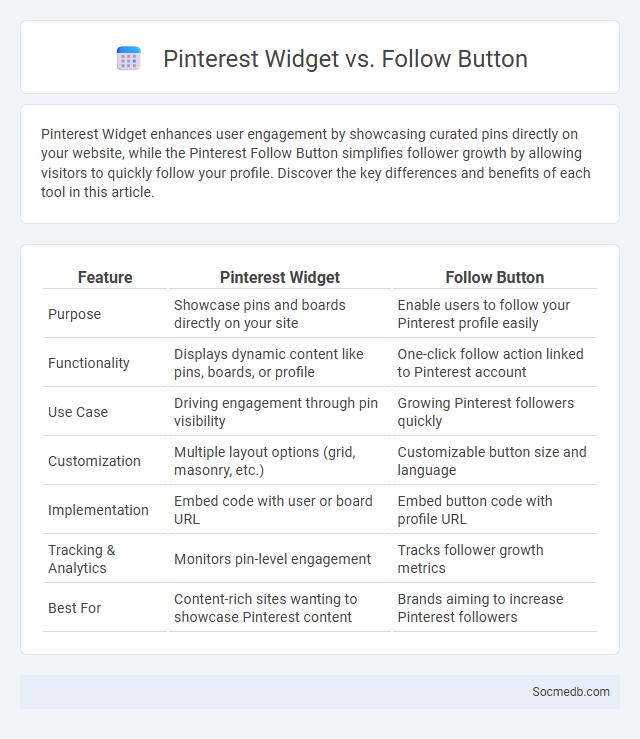
Photo illustration: Pinterest Widget vs Follow Button
Pinterest Widget enhances user engagement by showcasing curated pins directly on your website, while the Pinterest Follow Button simplifies follower growth by allowing visitors to quickly follow your profile. Discover the key differences and benefits of each tool in this article.
Table of Comparison
| Feature | Pinterest Widget | Follow Button |
|---|---|---|
| Purpose | Showcase pins and boards directly on your site | Enable users to follow your Pinterest profile easily |
| Functionality | Displays dynamic content like pins, boards, or profile | One-click follow action linked to Pinterest account |
| Use Case | Driving engagement through pin visibility | Growing Pinterest followers quickly |
| Customization | Multiple layout options (grid, masonry, etc.) | Customizable button size and language |
| Implementation | Embed code with user or board URL | Embed button code with profile URL |
| Tracking & Analytics | Monitors pin-level engagement | Tracks follower growth metrics |
| Best For | Content-rich sites wanting to showcase Pinterest content | Brands aiming to increase Pinterest followers |
Overview of Pinterest Integration Tools
Pinterest integration tools enable businesses to seamlessly connect their websites, products, and marketing campaigns with the Pinterest platform, driving higher user engagement and brand visibility. Key tools include Pinterest Tag for tracking user interactions, API access for automated content sharing, and rich pins that display enhanced product information directly on the platform. These tools facilitate targeted advertising, improve analytics, and streamline content management to maximize social media marketing effectiveness.
What is the Pinterest Widget?
The Pinterest Widget is a customizable tool that allows users to showcase Pinterest content directly on their websites or blogs, enhancing visual engagement and driving traffic. It supports various formats, including boards, profiles, and individual pins, enabling seamless integration with different web platforms. This widget uses Pinterest's API to update automatically, ensuring that the displayed content remains fresh and aligned with the latest user activity.
Understanding the Pinterest Follow Button
The Pinterest Follow Button enables users to easily subscribe to their favorite accounts and boards, increasing engagement and expanding reach. Integrating this button on websites or blogs allows seamless connection to Pinterest profiles, driving traffic and boosting brand visibility. Optimizing the button placement and design enhances click-through rates, making it a vital tool for social media marketing strategies.
Types of Pinterest Widgets
Pinterest widgets enhance Your website engagement by integrating visual content directly from Pinterest boards, profiles, or pins. Key types include the Pin Widget for showcasing individual pins, the Board Widget to display curated boards, and the Profile Widget which highlights a complete Pinterest profile. These widgets boost user interaction and drive traffic by embedding interactive, dynamic Pinterest content seamlessly on Your site.
Key Differences: Widget vs Follow Button
A social media widget offers interactive features like displaying feeds, likes, or comments directly on your website, enhancing user engagement by showing dynamic content from platforms such as Instagram or Twitter. In contrast, a follow button provides a straightforward call-to-action, allowing users to quickly subscribe to your social media profile without leaving your site. Choosing the right option depends on Your goal to either showcase live social media content or to increase your follower count efficiently.
Benefits of Using Pinterest Widgets
Pinterest widgets enhance user engagement by seamlessly integrating visual content and driving traffic directly from websites to Pinterest profiles. These widgets offer increased brand visibility and facilitate content discovery through interactive pins, boards, and follow buttons. Leveraging Pinterest widgets boosts social sharing and improves SEO by providing rich, keyword-optimized images that attract targeted audience interactions.
Advantages of the Pinterest Follow Button
The Pinterest Follow Button enables seamless connection with relevant boards, increasing user engagement and brand visibility. It drives targeted traffic by allowing users to discover and save content directly from websites to their Pinterest feeds. Enhanced user interaction through this feature fosters a loyal community and boosts social sharing potential.
Use Cases: When to Use Each Tool
Social media platforms serve distinct purposes based on user goals and audience engagement strategies. Instagram excels in visual storytelling for brands aiming to showcase products through images and short videos, while LinkedIn is optimal for professional networking, B2B marketing, and industry thought leadership. Twitter remains the go-to tool for real-time updates, customer service communication, and trend monitoring, making it essential for brands prioritizing timely interactions.
How to Add Pinterest Widgets and Follow Buttons
Adding Pinterest widgets and follow buttons enhances your website's engagement by allowing visitors to easily share content and follow your Pinterest profile. You can integrate Pinterest widgets by copying the widget code directly from the Pinterest Widget Builder and pasting it into your site's HTML where you want the widget to appear. Your visitors will benefit from quick access to your Pinterest boards, boosting your social media presence and driving more traffic to your content.
Which Pinterest Tool is Best for Your Website?
Choosing the best Pinterest tool for your website depends on your specific goals, whether it's increasing traffic, enhancing SEO, or managing content scheduling. Tailwind offers powerful scheduling and analytics features perfect for marketers aiming to grow Pinterest engagement efficiently. If you want seamless integration, Pinterest's own widget builder provides easy-to-add pins, boards, and profiles that boost user interaction directly on your site.
 socmedb.com
socmedb.com